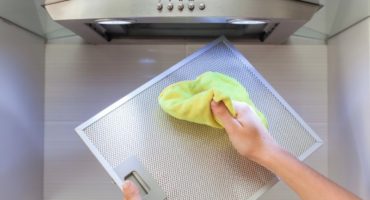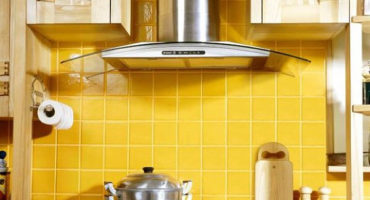- Features of the installation of kitchen hoods
- How to safely install a hood in the kitchen
- Tools and materials necessary for work
- How to install an inclined or domed hood over a gas stove: the main steps
- How to independently connect the hood in the kitchen to electricity
- Features of mounting a built-in hood
- Hood installation height
- How to choose an exhaust duct in the kitchen
- Conclusion
Many when buying a new hood are not sure whether they can install it on their own, preferring to contact specialists. This work does not cause difficulties, it is enough to have initial skills in handling the drill and to understand electricity. Another important point is the correct choice of model in accordance with the room. Productivity should be 10 times the volume of the kitchen. The design of the product may be different, but the installation principle is almost the same. Consider the step-by-step process of mounting the hood over the stove and the main features that may occur during operation.
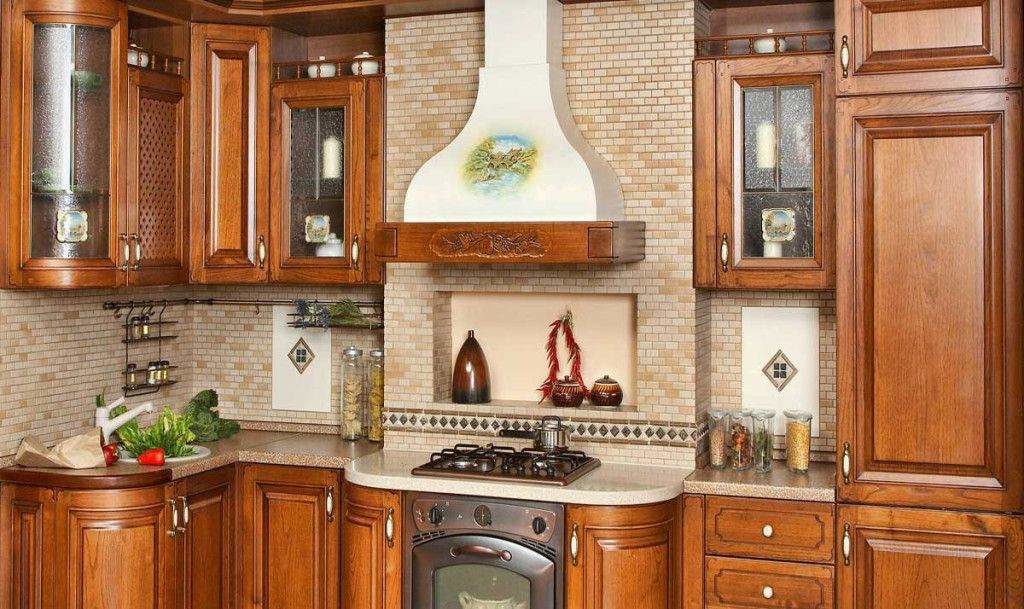
The hood is selected based on the area of the kitchen and the overall design
Features of the installation of kitchen hoods
Manufacturers produce different hoods that differ in the method of attachment:
- built-in - are installed in the cabinet in the form of a slider;
- flat - this is an independent device, it does not need access to the ventilation shaft. Contaminated air is driven through a filter system and discharged back into the room;
- angular - this model is chosen if the hob is placed in the corner. The exhaust system can be inlet through the duct or recirculation;
- domed, inclined, mantelpiece - occupy all the space above the stove, attached to the wall surface;
- island - is installed on the ceiling above the hob; they occupy quite a lot of space.
When choosing, it is important to comply with the norms of placement above a gas stove or hob.
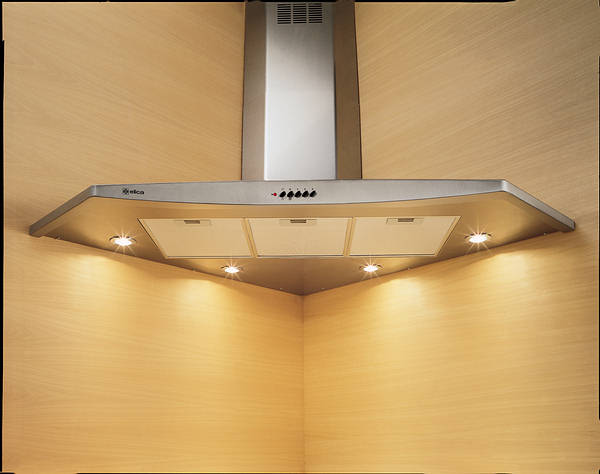
The corner hood will fit perfectly into the kitchen design
How to safely install a hood in the kitchen
A range hood is an electrical appliance, so it is important to take care of safety during its operation.
- In any model, fat and moisture accumulate and a breakdown can occur, as a result of which current will pass through the housing. In this case, a high probability of electric shock. Therefore, first of all, it is necessary to ground the device. Modern apartments are equipped with a grounding circuit, you do not need to do anything else, just turn on the hood.
If there is no grounding, it is necessary to draw a circuit yourself. For this, a 3-core wire, the cross section of which is 2.5 mm², is suitable. It does not need to be carried out to the street or mounted to radiators, it is enough to simply extend it to the electrical panel, in which it is connected to a neutral neutral. If the wiring is already connected to it, you just need to fix your wire on top.
- When installing the hood, one more rule should be followed - the distance from the hob to the bottom of the appliance should be within the limits defined by the manufacturer in the product passport.
- Another important safety parameter - the throughput of a ventilation shaft should be higher than that of an exhaust device. Otherwise, the contaminated air masses will return to the kitchen or to neighbors through other openings in the ventilation duct.
- The installation of the hood must be reliable, the fastening is strong enough so that during cooking it does not fall on a hot stove. Especially you need to be careful if the installation is done on drywall. In this case, it is necessary to additionally strengthen the place with the help of wooden bars.
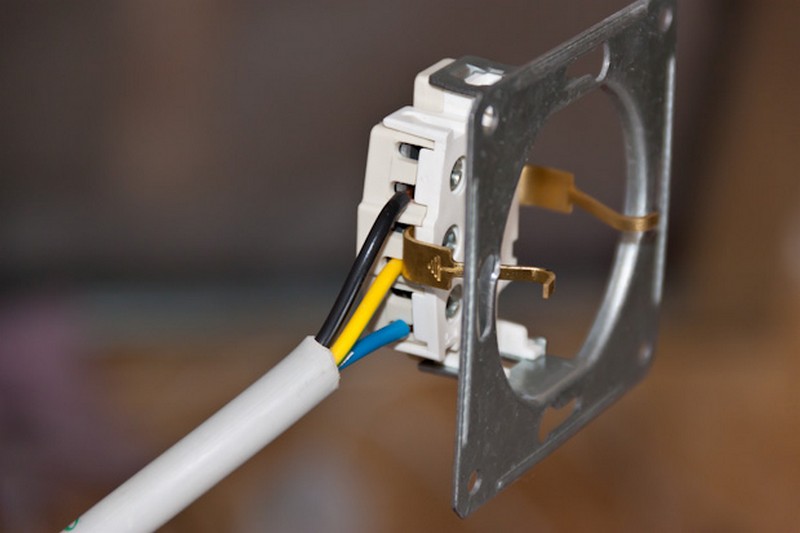
Installing a grounded power outlet for safety reasons
Tools and materials necessary for work
Before you begin, you need to prepare the following tools and materials:
- air duct, if necessary additional elements;
- hammer drill. A drill with a shock function is also suitable, this will complicate the work a little if the walls are concrete;
- screwdriver;
- measuring tape or tape measure;
- level;
- hammer;
- fasteners;
- if necessary, a sheet of drywall, metal guides;
- primer, paint, brush, putty and tools for its application.
If an expensive tool is not available, it is impractical to purchase it for mounting one hood. Many stores offer rental equipment for a short time. Installation will take no more than 2-3 hours, rent will not be expensive.
How to install an inclined or domed hood over a gas stove: the main steps
Mounting inclined and dome hoods practically does not differ, it should not cause difficulties and is quite capable of doing it yourself, while saving some of the family budget. Consider the entire installation process in stages.
Recirculation hood installation
Such a treatment system does not require a connection to the ventilation shaft, so it just needs to be fixed to the wall. This is a good solution for private houses or apartments in which the stove is installed far from the ventilation system.
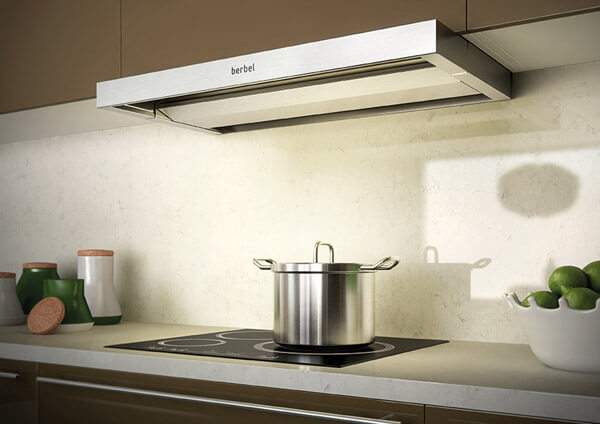
Recirculation hood can be installed under the upper furniture, if the height allows
Check Valve Installation
First of all, a cracker is installed in the ventilation system or a check valve. It is necessary to prevent air from returning into the room. It is easy to make it yourself, for this you can take a piece of tin and make a box, the diameter of which should be 3/4 of the cross-section of the duct.
Next, you need to take a small sheet of aluminum with a thickness of 5 mm, cut the damper and fasten it to the spring to the duct so that the air flows when leaving the room push it out. During reverse air movement, the shutter must be closed.
The spring can be made of wire 120 mm long, 5 mm wide and 0.3 mm thick. Her preload should close the forced open damper and return to its original position.
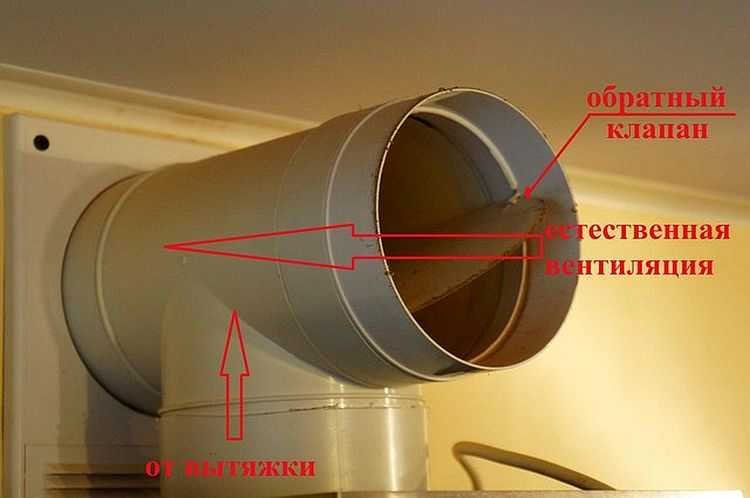
The principle of the check valve
Mounting the hood
After installing the crackers, the hood should be mounted on the wall. Manufacturers simultaneously with the equipment ensure the availability of fasteners. It is necessary to carefully measure the distance, the placement standards are indicated in the passport on the product, check the horizontal with a level and drill a hole with a drill or puncher. Then drive in the dowel and screw in the screws.

Fastening the hood to the wall using self-tapping screws
Duct installation
The easiest way to install a corrugated pipe. It can be stretched to the required parameters or cut with scissors. During the operation of the hood, it does not produce additional noise and has excellent aerodynamics. The duct must be connected with one side to the pipe, the other must enter the ventilation shaft.
Previously, a check valve should be placed in the channel, the body of which should be attached to the wall. You can fix the duct connections using clamps. After that, the entire structure must be closed with a drywall partition or a plastic box.
If the fan shaft is located far from the hood, you can stretch the duct and a long distance. It should be remembered that with every turn of the corrugation 10% of the pipe capacity is lost.In addition, it does not look very aesthetically pleasing. Therefore, in this case, it is worth thinking about moving the hob closer to the ventilation hole.
When installing the duct, there must be a gap between the ceiling and the pipe. This must be done due to the fact that during the operation of the hood there is a slight vibration of all elements, which can damage the ceiling.
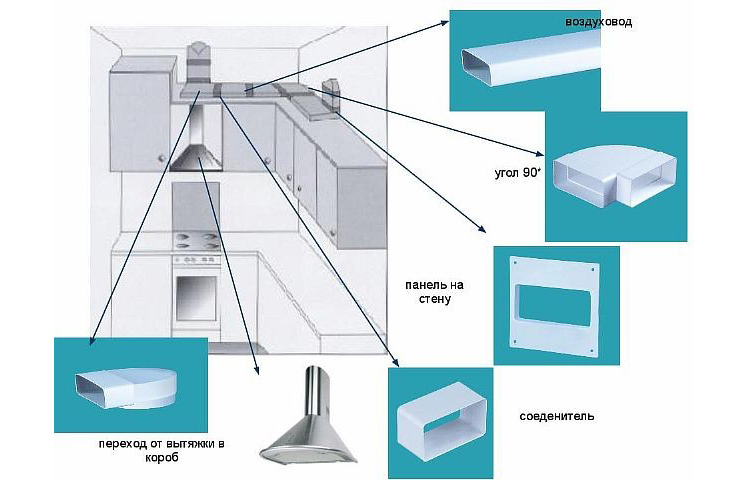
Installation and connection of a plastic duct
How to independently connect the hood in the kitchen to electricity
Before installing the hood, you should first check the length of the cord and the distance to the outlet. Carrying in this case is not advisable, it is better to immediately transfer the outlet, while you can not place it near the heating equipment or water. The most optimal place is to lay hidden wiring over the cabinets.
You can transfer the outlet yourself or invite a specialist. Then you need to plaster the place and decorate the place after repair
Features of mounting a built-in hood
The built-in hood in its technical parameters does not differ from the inclined or dome model. The main difference is in the design, for example, the casing in a high product performs a decorative function. With proper installation, the hood is almost invisible in the kitchen, only the control panel remains in range. It is suitable for small rooms or kitchens decorated in country style, classic or rustic design.
To install such a design in the house, certain professional skills are required. To place it, you need a cabinet that is installed at the required distance above the stove. You can take away existing furniture for exhaust equipment or make a cabinet individually.
Consider the step-by-step process of installing a hood in already mounted furniture.
- Remove the bottom and shelves in the cabinet. You can install additional hardware for rigidity.
- In the upper panel you need to cut a hole for the subsequent installation of the duct. It can be cut with a jigsaw.
- Install the hood in the cabinet and secure with screws.
- Next, you should hang in place the cabinet with the hood.
- Install and secure the duct.
- Connect and test the system.
The corrugated duct in sight can ruin the design of any kitchen. It is recommended to hide it inside the furniture or use a decorative model. As an option, install a plastic structure that visually looks much better.
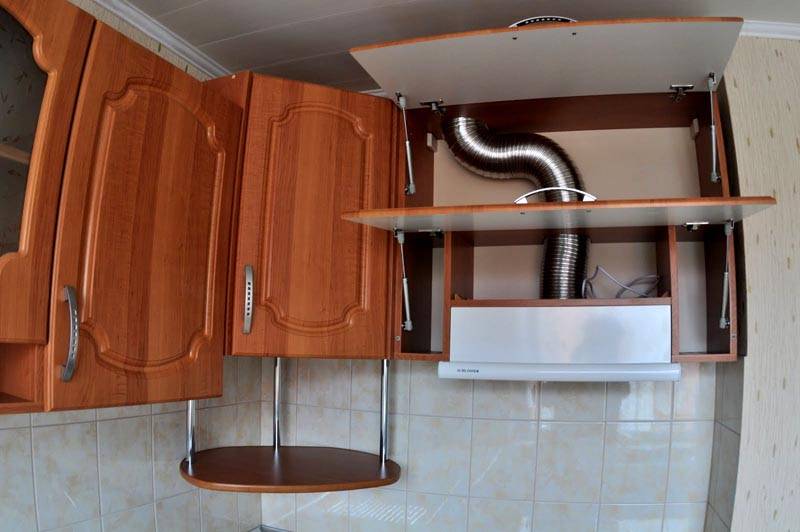
Cabinet installation sequence
Hood installation height
Manufacturers indicate the dimensions in the technical annotation for the product, since they directly depend on the power of the equipment. The optimal installation height of the hood above the hob or stove should be in the range from 65 to 95 cm from the bottom of the model to the burners:
- for gas - from 75 cm to 90 cm;
- for electric - from 65 cm to 70 cm.
If you install the hood below, individual elements may suffer under the influence of high temperature, steam and spray.
You can install the hood at a height of more than 90 cm only if the power of the equipment allows.
How to choose an exhaust duct in the kitchen
Air purification in the kitchen depends not only on the power and performance of the equipment, but also on a properly selected duct. The distribution network offers the following elements:
- corrugated pipe made of aluminum foil of circular cross section, the main advantage of which is low cost. The air duct bends well, thanks to this installation does not cause difficulties. Additional elements for organizing air purification are not needed, only clamps may be needed, with which it is necessary to fix the corrugation to the hood and the ventilation grid.
The disadvantages include uninteresting appearance and vibration during operation of the device at high power;
- rigid pipes made of plastic - for the installation of a ventilation duct, it is necessary to purchase transitional parts: turns, connections. Elements produce round and rectangular sections. The finished design has a presentable appearance and good sound insulation. The main advantage of rigid pipes is its low height, so that it can be hidden even in a suspended ceiling.
When choosing an air channel, you should be guided by the diameter of the outlet - socket, in addition, it is important to correctly measure the distance to the ventilation shaft. For a corrugated pipe, the difference with improper measurements will not affect the installation, for a rigid duct this is fraught with the acquisition of extra parts.
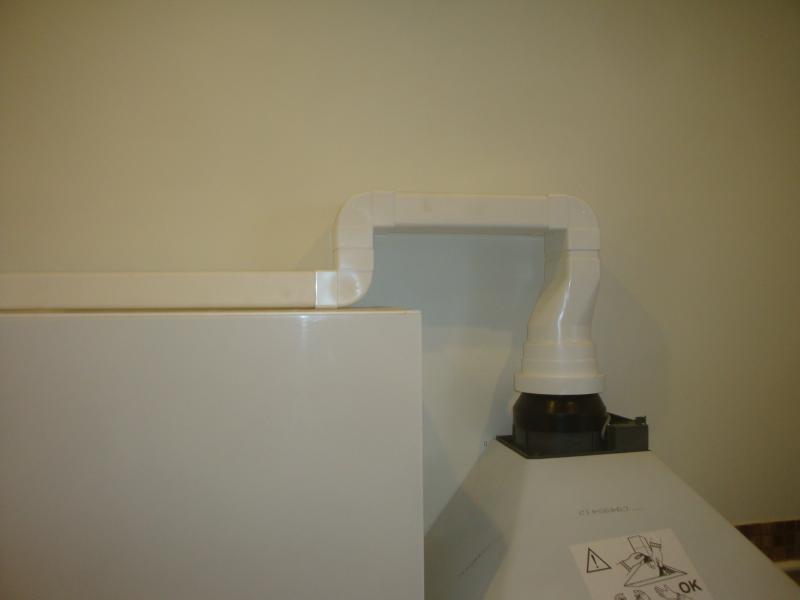
A variety of elements of the plastic duct allows complex strapping
Conclusion
To install the hood over a gas or electric stove it will take 1-2 hours, work does not cause difficulties. Therefore, before contacting professionals, it is worth trying to install it yourself. It is important to observe safety precautions and take into account all the features that we talked about. And then its operation will reliably protect the room from unpleasant odors.

The hood-slider installed in the cabinet does not clutter the kitchen space

